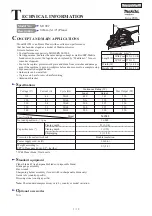
-54-
Model W1864/W1865 (For Machines Mfd. Since 02/19)
SE
RV
IC
E
Machine.Operation
PROBLEM
POSSIBLE.CAUSE
CORRECTIVE.ACTION
Excessive snipe
(gouge in end
of board that is
uneven with rest
of cut).
Note: A small
amount of snipe
is inevitable with
all types of plan-
ers. The key is
minimizing it as
much as possible.
1. One or both of bed rollers are set too high.
2. Outfeed extension slopes down or is not level
with main table.
3. Chip breaker set too low.
4. Workpiece is not supported as it leaves
planer.
5. Some snipe is inevitable.
1. Lower bed rollers (
Page.29
).
2. Shim outfeed extension wing level with main table.
3. Raise height of chip breaker (
Page.43
).
4. Hold workpiece up slightly as it leaves outfeed end
of planer.
5. Plane lumber longer than your intended workpiece
length, then cut off excess after planing complete.
Workpiece stops/
slows in middle
of cut.
1. Taking too heavy of a cut.
2. One or both of bed rollers are set too low or
too high.
3. Chip breaker or pressure bar set too low.
4. Feed rollers set too low or too high.
5. Pitch and glue buildup on planer components.
1. Take a lighter cut.
2. Adjust bed rollers (
Page.29
).
3. Raise height of chip breaker or pressure bar (
Page.
43
).
4. Adjust feed rollers (
Page.43
).
5. Clean internal cutterhead components with a
pitch/resin-dissolving solvent.
Chipping (consis-
tent pattern).
1. Knots or conflicting grain direction in wood.
2. Taking too deep of a cut.
3. Feeding workpiece too fast.
4. Mis-adjusted chip breaker.
5. Nicked or chipped knife/insert.
1. Inspect workpiece for knots and grain direction;
only use clean stock, and cut WITH the grain.
2. Take a smaller depth of cut. (Reduce cutting depth
when planing hard woods.)
3. Slow down feed rate.
4. Adjust both sides of chip breaker to correct height.
5. Replace affected knife (
Page.31
), or have it sharp-
ened; rotate/replace insert (
Page.34
).
Chipping/
indentation in
workpiece sur-
face (inconsistent
pattern).
1. Chips aren't being properly expelled from
cutterhead.
2. Chip breaker not set correctly.
1. Use a proper dust-collection system.
2. Correctly adjust chip breaker (
Page.43
).
Fuzzy grain.
1. Wood may have high moisture content or sur-
face wetness.
2. Dull knives/inserts.
1. Check moisture content is below 20% and allow to
dry if moisture is too high.
2. Replace knives (
Page.31
) or have them profession-
ally sharpened; rotate/replace inserts (
Page.34
).
Long lines or
ridges that run
along length of
board.
1. Nicked or chipped knife/inserts.
1. Replace knives (
Page.31
) or have them profession-
ally sharpened; rotate/replace inserts (
Page.34
).
Uneven cutting`
marks, wavy sur-
face, or chatter
marks across face
of board.
1. Feeding workpiece too fast.
2. Chip breaker or pressure bar set unevenly or
not low enough.
3. Knives not installed evenly/inserts not prop-
erly installed.
4. Worn cutterhead bearings.
1. Slow down feed rate.
2. Adjust height of chip breaker (
Page.43
).
3. Adjust knives with knife gauge (
Page.31
); remove
inserts, properly clean mounting pocket and re-
install (
Page.34
).
4. Replace cutterhead bearings.
Glossy surface.
1. Knives/inserts are dull.
2. Feeding workpiece too slow.
3. Cutting depth too shallow.
1. Replace knives (
Page.31
) or have them profession-
ally sharpened; rotate/replace inserts (
Page.34
).
2. Increase feed rate.
3. Increase depth of cut.
If workpiece
twists in
machine.
1. Feed rollers not parallel with table.
1. Adjust feed rollers (
Page.43
).
Summary of Contents for W1864
Page 73: ...Model W1864 W1865 For Machines Mfd Since 02 19...
Page 76: ......
















































